Abstract
Materials used for fixed partial denture (FPD) frameworks have had properties of excellent strength, durability, and biocompatibility. Some of the materials which have been used till date include alloys, ceramics, and high-performance polymers such as zirconia, Ni–Cr, lithium disilicate, and so on. All these, though excellent, have their advantages and disadvantages. Hence, the search has always been on for a better material. One such material, which has made its foray into dentistry in the recent times, is polyetheretherketone (PEEK). It is a semicrystalline thermoplastic material. PEEK has an excellent chemical resistance and mechanical properties that are retained at high temperatures. The versatility of PEEK as a dental material for FPD framework was evaluated in this case report.
Keywords: Fixed partial denture framework, polyetheretherketone, thermoplastic material
INTRODUCTION
Materials used for fixed partial dentures (FPDs) have evolved over the years. The earliest known usage of dental materials can be traced to 500 BC. Etruscans used Gold first to make dental bridges. Metals such s Ni and Cr were used for making the framework for fixed prosthesis. Nowadays, metal-free restorations are becoming more important in dentistry due to factors such as the increased esthetic requirements of the patient, legislation in some countries due to the possible material incompatibility being reported. Nowadays, more and more patients want to avoid incorporation of a metallic material in the mouth, and clinicians also want to follow this trend as it gives a better esthetic outcome to the restoration. Ceramic materials ideally meet the esthetic requirements, but they may also have a few material or technical disadvantages in some cases. Polyetheretherketone (PEEK) is a sulfonated aromatic high-temperature thermoplastic material. It belongs to the family polyaryletherketone. The versatility of this material in the medical field in long-term implantation includes artificial cranial plates, components of finger and knee joints, and intervertebral bodies (spine implants). It has been used in the field of orthopedic surgeries since the 1980s.[1]
Its use in dentistry has been substantial after its wide acceptance in the medical field. PEEK is a physiologically inert, water insoluble high-performance polymer. Based on these excellent physical and biological properties, though it lacks clinical long-term studies, this composite material seems to be suitable superstructure in dentistry, i.e., for dental implants, provisional abutments, implant-supported bars, clamps for removable prostheses, and fixed dental prosthesis.[2] PEEK matrix without filler was found to be more stable than with fillers in the nanoscale range.[3] Hence, unfilled PEEK Optima (Invibio) was used as an FPD framework in this case report.
CASE REPORT
A 32-year-old male patient reported to the Department of Prosthodontics, Sri Sai College of Dental Surgery, Vikarabad, Telangana, India, to replace his broken FPD. He apparently had lost his teeth in a road traffic accident 6 years back. These were replaced with an FPD extending from 12–25 to 42–33. The patient also had an alveolar defect in the anterior teeth region both in the upper and lower jaw but was not willing for surgical correction of the same [Figure 1].
Figure 1.
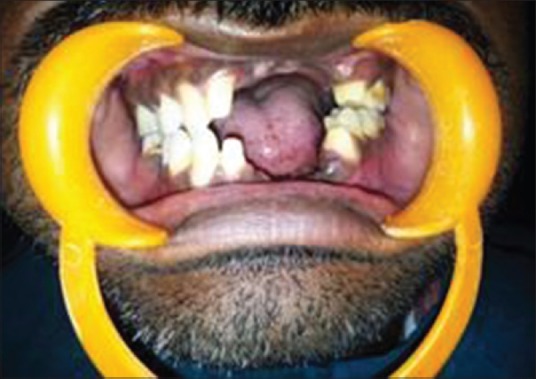
Preprocedural presentation of the patient
Procedure
Tooth preparation was carried out from 13–26 to 43–34 as the abutment support was found to be less in the already prepared teeth. After gingival retraction with a 000 cord (Ultrapak), the final impression was made with Putty (Regular body-Aquasil) and light body (Aquasil) impression material. Temporization was done with tooth colored autopolymerizing methyl methacrylate resin. Pink color autopolymerizing resin was used to replicate the gingiva in the area of bony defect. Wax pattern was fabricated on a master cast obtained. Micro-retention beads (Ivoclar Vivadent) were sprinkled on the wax pattern [Figure 1]. Bresol investing liquid and investment material were used for investing the wax patterns [Figure 2]. Bio high-performance polymer was taken and was used as the material for casting the framework. Seven grams of PEEK was all that was required for casting of both the upper and lower frameworks [Figure 3]. The investment ring and the filler were placed in a four stage burnout machine and the burnout temperature was set according to the manufacturer's recommendations. After the wax burn out, the casting ring and filler were placed in the For2Press system with the filler fixed above the investment. The casting ring mold was filled with PEEK granules. The heated filler helped in vacuum compression of PEEK granules into the investment ring. Adequate pressure and temperature were maintained and PEEK was flown into the ring, and the casting was completed [Figure 4]. As the density of PEEK material is very less (1.28–1.32 g/cm3), the castings obtained were very light in weight. The vacuum under pressure ensured a homogeneous and porosity-free framework. The fit of the PEEK framework was checked in the patient's mouth [Figures 5 and 6]. The micro-retention beads helped in mechanical retention with the nanocomposite (Adoro). SR Adoro link was applied over the framework which acted as an adhesive. Nanocomposite called SR Adoro™ was layered and fired in the Lumamat 100 light furnace. The micro-retentive beads and the adhesive helped in the bonding of PEEK with Adoro composite material. The finished prosthesis with PEEK as its framework and Adoro layered over it was cemented with RelyX self-cure resin luting agent [Figure 7]. There was a high degree of patient comfort and satisfaction because of the light weight and better esthetics.
Figure 2.
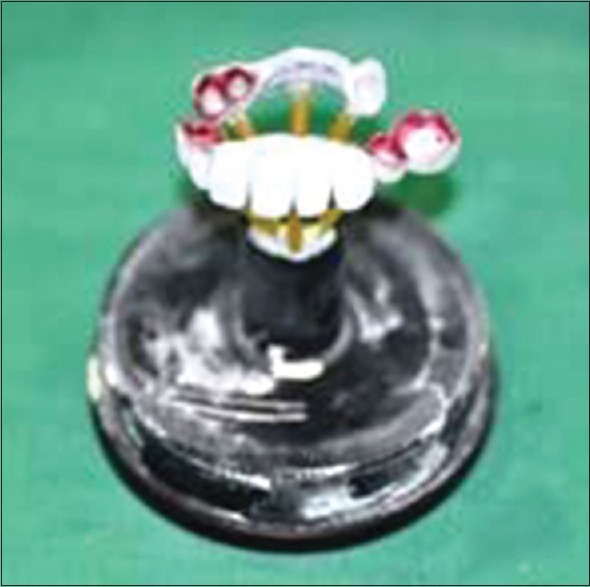
Micro-retention beads sprinkled on wax pattern
Figure 3.
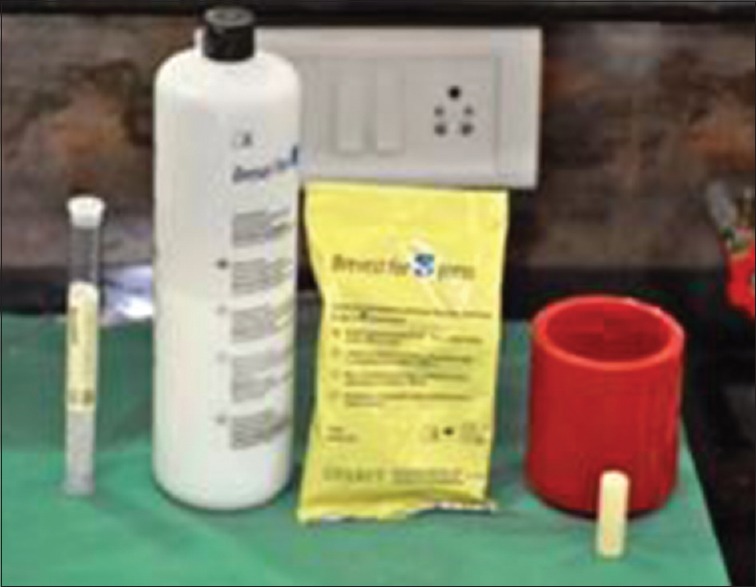
Bresol investment liquid and investment material
Figure 4.
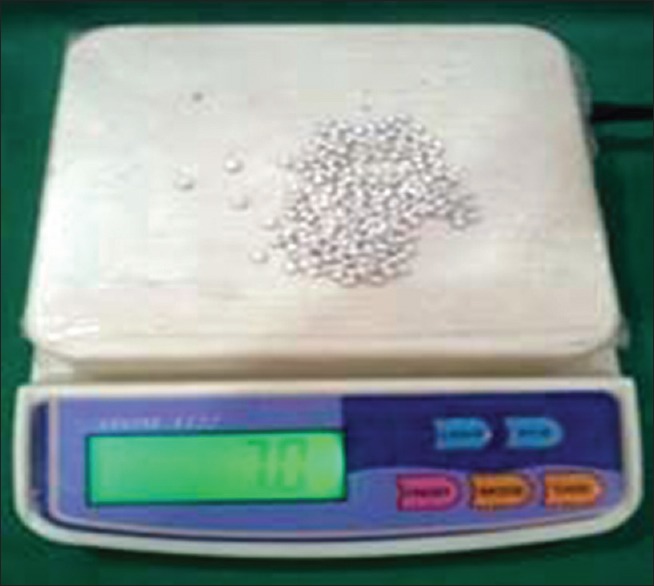
Seven grams of polyetheretherketone dental material
Figure 5.
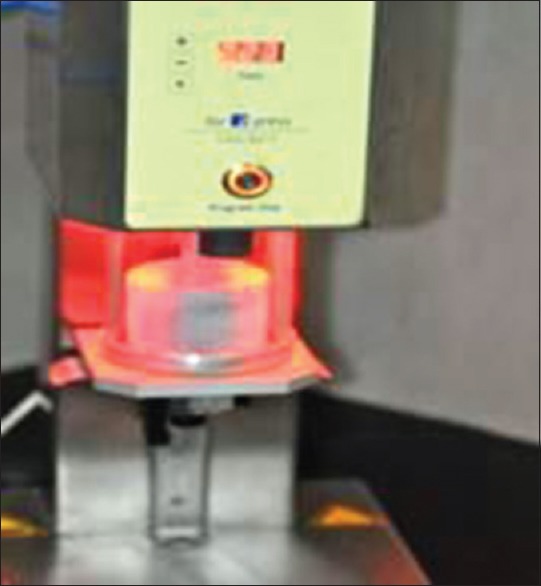
For2Press unit used for vacuum pressing the material
Figure 6.
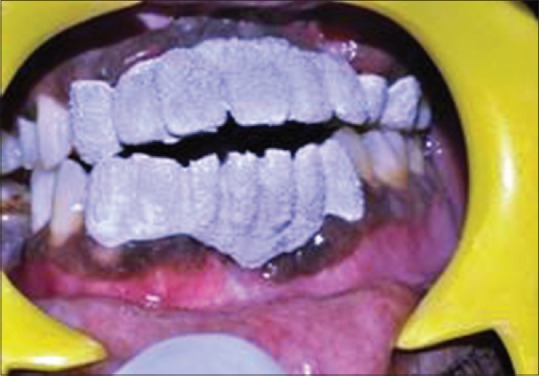
Polyetheretherketone framework try in
Figure 7.

Postcementation
DISCUSSION
Two or more substances, when combined at a microscopic level, form a material which may demonstrate macroscopic physical properties which are superior to the parts used to join them together. They are called “composite” materials. A composite is formed when the reinforcing component consists of long continuous fibers.[4] The past decade has seen increasing interest in PEEK as an alternative to metals. Its mechanical and biological properties, as well as its translucency to X-rays, have been of interest. Historically, the availability of polyaromatic polymers began at a time when there was an interest to develop “isoelastic” hip stems and fracture fixation plates. These showed a stiffness comparable to that of human bone. The filler content makes PEEK implants isoelastic with the elasticity (Young's modulus) and density identical to bone. Pure polyaromatic polymers exhibit elastic modulus that varies from 3 to 4 Gpa. This value can be further increased to achieve a modulus of 18 Gpa which is closer to human cortical bone with the addition of fibers. This reduces the risk of stress shielding around the implants. It also makes PEEK suitable for use in orthopedic and spinal surgery.[1]
PEEK was introduced to dental applications in 1992, first in the form of esthetic abutments and later as implants.[4] Many variations in PEEKs composition have been carried out to improve the working characteristics. The reinforcing agents are carbon fibers, beta-tricalcium phosphate, hydroxyapatite, or titanium dioxide added to the PEEK matrix.[5] PEEK has been found to be resistant to nearly all organic and inorganic chemicals and has also shown adequate physical and mechanical properties. The stable chemical structure of PEEK has been shown to be extremely unreactive and inherently resistant to chemical and thermal degradation.[6] The inertness of the polymer also explains its biocompatibility, which has been shown both in vitro and in vivo. PEEK frameworks are also shock absorbent during chewing and have a high resistance to abrasion and decay.[7] Direct bone contact next to the implant has also been observed.[1,4,8] Because of the immense versatility, it was soon realized that it could play multiple roles in the enhancement of prosthodontic rehabilitation and hence was used as a long span FPD framework in the present case report.
PEEK has also been particularly attractive for computer-aided design and computer-aided manufacturing framework fabrication in prosthetic dentistry. In comparison to the traditional materials previously used, PEEK had an abundance of advantages owing to its excellent properties. It has a high strength to weight ratio, elastic properties similar to human bone, zero corrosion rate,[7] and extremely low water absorption.[9] The Young's modulus of unfilled PEEK is 3.6 Gpa, tensile strength 90–100 Mpa and density is 1.28–1.32 g/cm.[3] The low density made the prosthesis very light in weight. Comparatively, the amount and weight of pellets which would have been required for casting the same framework in Ni–Cr would have been much higher. PEEK has a glass transition temperature of around 143°C and melting temperature of 343°C. It is highly resistant to thermal degradation and also to attack by both organic and aqueous environments.
Owing to all these properties, which do not exist in the oral environment, PEEK has been used as a biomaterial of choice in dentistry. In the present case report, PEEK granules have been used as a framework for long span FPD which was finally layered with a nanocomposite called Adoro SR™. The standard technical procedure for manufacturing the framework was followed. The framework obtained was found to have satisfactory esthetics, marginal fit, and stability in the patient's mouth. The microcrystal granules provided the mechanical retention and SR Adoro Link helped in chemical retention for the nanocomposite which was used as a layering material over the PEEK framework. It was strong and lightweight for improved patient comfort. The compression molding ability under vacuum in the For2Press system provided proper coverage to the dies, the metal-free denture framework was taste neutral (no metal taste),[10] had no thermal or electrical conductivity, was X-ray, and scanner friendly and was nonallergenic.
CONCLUSION
The 2, 3, and 6 months follow-up of the patient showed very little plaque accumulation and healthy gingiva around the teeth which highlighted the biocompatible nature of the material. The experience of utilizing PEEK as a framework for FPD yielded very satisfactory results with high degree of patient comfort and acceptability due to its light weight nature. We believe that PEEK definitely will play a more enhanced role in the fabrication of FPD frameworks in near future and will have a long-lasting effect on the esthetics and functional capability of oral rehabilitation of patients using this material. Although the technique is sensitive and equipment oriented, long-term implication studies will enhance the reputation of PEEK as FPD framework material.
Financial support and sponsorship
Nil.
Conflicts of interest
There are no conflicts of interest.
REFERENCES
- 1.Kurtz SM, Devine JN. PEEK biomaterials in trauma, orthopedic, and spinal implants. Biomaterials. 2007;28:4845–69. doi: 10.1016/j.biomaterials.2007.07.013. [DOI] [PMC free article] [PubMed] [Google Scholar]
- 2.Stawarczyk B, Beuer F, Wimmer T, Jahn D, Sener B, Roos M, et al. Polyetheretherketone-a suitable material for fixed dental prostheses? J Biomed Mater Res B Appl Biomater. 2013;101:1209–16. doi: 10.1002/jbm.b.32932. [DOI] [PubMed] [Google Scholar]
- 3.Stawarczyk B, Eichberger M, Uhrenbacher J, Wimmer T, Edelhoff D, Schmidlin PR. Three-unit reinforced polyetheretherketone composite FDPs: Influence of fabrication method on load-bearing capacity and failure types. Dent Mater J. 2015;34:7–12. doi: 10.4012/dmj.2013-345. [DOI] [PubMed] [Google Scholar]
- 4.Kurtz SM. PEEK Biomaterials Handbook. 1st ed. Elsevier Science; 2011. [Google Scholar]
- 5.Dumitriu S, Popa V. Polymeric Biomaterials: Structure and Function. 1st ed. CRC Press; 2013. [Google Scholar]
- 6.Murray G. Handbook of Materials Selection for Engineering Applications. CRC Press; 1997. [Google Scholar]
- 7.Whitty T. A new tool for computer-aided design and manufacturing. Dent Asia. 2015:76. [Google Scholar]
- 8.Callaghan JJ, Rosenberg AG, Rubash HE. The Adult Hip. 2nd ed. Lippincott Williams and Wilkins; 2006. [Google Scholar]
- 9.Janaki K, Elamathi S, Sangeetha D. Development and characterization of polymer ceramic composites for orthopedic applications. Trends Biomater Artif Organs. 2008;22:169–78. [Google Scholar]
- 10.Whitty T. PEEK – A New Material for CAD/CAM Dentistry. Juvora Dental Innovations; 2014. [Google Scholar]


